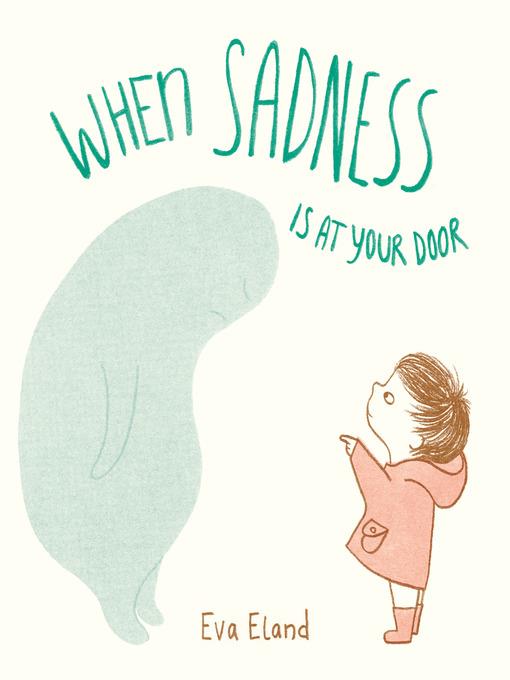
When Sadness is at Your Door
فرمت کتاب
ebook
تاریخ انتشار
2019
Reading Level
0-1
ATOS
1.9
Interest Level
K-3(LG)
نویسنده
Eva Elandشابک
9780525707196
کتاب های مرتبط
- اطلاعات
- نقد و بررسی
- دیدگاه کاربران
نقد و بررسی

November 1, 2018
Many books for young readers tackle terrible tantrums, but few address sadness that surfaces perhaps for no reason at all; this gives that muted malaise a shape, an identity, and love.A child tentatively opens the door and finds Sadness, a towering, amorphous, pale teal figure, waiting on the other side. It has arm and leg stumps but no neck or waist. Text set in a type that emulates handwriting tells children what they already know: "Sometimes Sadness arrives unexpectedly." The playful interplay between the literal and the figurative makes engaging a tough topic pleasurable. In casting melancholy not as an enemy but as a sometime companion, this powerful picture book inspires empathy and action. The hand-drawn illustrations' extremely limited, three-color palette (a washed-out blue for Sadness' ghostly, blobby body, subdued circles of pink on the child's cheeks, and chocolate brown for the lines that etch their world) similarly channels depression in its constriction of color. The ungendered, light-skinned child trudges alongside Sadness with slumped shoulders as they enact the sound, practical coping tactics introduced by the narrative voice. "Try not to be afraid of Sadness. Give it a name....Find something that you both enjoy, like drawing." Front endpapers show depressed people ignoring their sadnesses, while back endpapers show these same characters interacting with them and feeling better.Children will feel better, too, knowing they have a helpful, honest, and empathetic picture book ready for the next time Sadness shows up for a visit. (Picture book. 4-10)
COPYRIGHT(2018) Kirkus Reviews, ALL RIGHTS RESERVED.

December 1, 2018
K-Gr 3-This gentle book portrays sadness as a large pale green visitor that appears at the door, suitcase in hand. "It follows you around...and sits so close to you, you can hardly breathe." The narrator advises the host-a small child-not to hide his sadness or be afraid. "Listen to it. Ask where it comes from and what it needs. If you don't understand each other, just sit together and be quiet for a while." Then, try doing something comforting together like drawing, listening to music, or drinking cocoa. And, just as it came, unexpectedly, one day it will be gone. By focusing on the feeling, rather than the circumstance, the book speaks to readers of all ages and backgrounds. The portrayal of the feeling as so much larger than the boy helps convey the overwhelming nature of the emotion. The front endpapers show people of different ages in sad, thoughtful poses with the green creature interspersed-laying down, crying, staring at the ground, etc. The back endpapers show "sadness" doing yoga, petting a cat, taking a bath, eating an ice cream, getting a hug...finding comfort where it can. The handwritten text and illustrative sketches are rendered in brown on cream paper with pale red and green accents. VERDICT This quiet book is both constructive and reassuring and recommended for any collection with a bibliotherapy section.-Barbara Auerbach, Cairo Public Library, NY
Copyright 2018 School Library Journal, LLC Used with permission.

lulucreepypasta - I had bought this book for my sister

January 1, 2019
Preschool-G In intimate, direct-address prose and uncomplicated sepia line illustrations with a muted palette, this picture book represents sadness as a large, blue-hued amorphous figure that appears in a child's life: Sometimes, Sadness arrives unexpectedly. No reason is given; it's just at the door, carrying a suitcase. But by externalizing sadness and giving it presence?here, more soft and expressive than intimidating?Eland portrays the many ways it can feel, from sitting so close to you, you can hardly breathe to like you've become Sadness yourself, accompanied by an image of the child overlaid by the translucent Sadness, while other children play nearby. Also, however, she invites readers to look at sadness with new perspective and offers potential coping strategies. Eventually, just as unpredictably, it might be gone . . . today is a new day. While its blend of literal and metaphorical may be esoteric for some younger ones, this ultimately explores a complex feeling with support and nonjudgmental compassion, while offering an affirming way to understand, discuss, and view sadness that children?and their adults?may find helpful.(Reprinted with permission of Booklist, copyright 2019, American Library Association.)

























دیدگاه کاربران